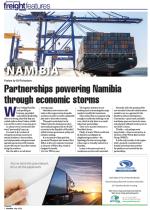Plans are rolling out for the Walvis Bay corridors to be transformed from transport routes into economic development corridors, says Hippy Tjivikua, chief executive officer of the Walvis Bay Corridor Group (WBCG).The objective is to add value to the products currently moving on the corridors through warehousing, processing, packaging and manufacturing.One of the most promising commodities is fertiliser, which would be stored in Walvis Bay and blended for use in Namibia and neighbouring countries, he says.
“There has been a positive response to proposals that Walvis Bay be used for the importation of fertiliser from the farming communities in Zambia and Zimbabwe.”For shippers using the Walvis Bay-Ndola-Lubumbashi Development Corridor the advantage is that the fertiliser will help balance loads between the Copperbelt and Walvis Bay.
There is support at the highest level for the monetisation of the corridors, with the WBCG supporting the government’s Namibia Logistics Hub project. The project aims to deepen economic integration, put in place measures to improve competitiveness, and enhance closer trade and investment linkages.Government policies and investments in road, rail, sea and air infrastructure have been informed by the vision of transforming the Namibian economy into the logistics gateway for the region.
Manufacturing is being attracted by the establishment of special economic zones on the corridors. The first step in the repositioning of the Namibian economy was to develop reliable logistics corridors linking Walvis Bay with the neighbouring countries.In support of this the WBCG has opened offices in the main centres of Johannesburg, Lusaka and Lubumbashi.“Our regional offices have continued to provide support for the users of the corridors during the Covid-19 shutdown,” says Tjivikua.
He sees the relative lack of value-added development on the corridors as an advantage – investors will be able to take full advantage of Industry 4.0 technology and systems.“We are in the process of digitising the corridors in order to support fourth industrial revolution companies.
“Digitisation will also help us to ‘green’ the corridors by optimising the way freight is handled and transported. We are aiming for seamless multimodal transport systems, which include minimising border delays.”His personal challenge now, says Tjivikua, is to persuade industry leaders to start seeing the opportunities presented by digitisation, special economic zones, and the new Walvis Bay container terminal, among other advantages offered by Namibia.

